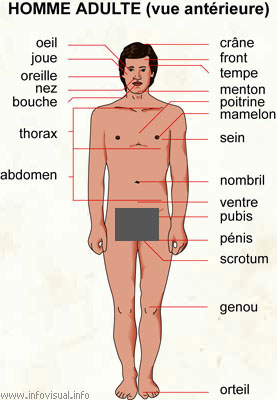Homme adulte (vue antérieure)

Crâne: Boîte osseuse contenant le cerveau.
Front: Partie du visage située entre la racine des cheveux et les sourcils.
Tempe: Partie de la tête située entre l'oeil et le haut de l'oreille.
Menton: Protubérance de la mâchoire située sous la lèvre inférieure.
Poitrine: Partie du haut du tronc délimitée par le diaphragme et les côtes.
Mamelon: Bosse conique formant la pointe du sein.
Sein: Partie antérieure de la poitrine ou se situent les mamelles.
Nombril: Cicatrice laissée par la section du cordon ombilical.
Ventre: Partie inférieure du tronc contenant les organes digestifs.
Pubis: Région inférieure du bas du ventre se couvrant de poils à la puberté.
Pénis: Organe reproductif externe de l'homme.
Scrotum: Chez l'homme, petit sac sous le pénis contenant les testicules.
Genou: Articulation entre la cuisse et la jambe.
Orteil: Doigt de pied.
Abdomen: Partie inférieure du tronc contenant les organes digestifs.
Thorax: Partie du haut du tronc délimitée par le diaphragme et les côtes.
Bouche: Entrée du tube digestif, située dans la partie inférieure du visage.
Nez: Partie protubérante du visage située entre la bouche et le front et qui est le siège de la respiration.
Oreille: Organe externe de l'ouïe.
Joue: Partie du visage située entre le nez et l'oreille, l'oeil et la mandibule.
Oeil: Organe de la vue.
Photo :

Domestic goats are one of the oldest domesticated species. For thousands of years, goats have been used for their milk, meat, hair, and skins all over the world. Most goats naturally have two horns, of various shapes and sizes depending on the breed. While horns are a predominantly male feature, some breeds of goats have horned females. Polled (hornless goats) are not uncommon and there have been incidents of polycerate goats (having as many as eight horns), although this is a genetic rarity thought to be inherited. Their horns are made of living bone surrounded by keratin and other proteins and are used for defense, dominance, and territoriality.
Goats are ruminants. They have a four-chambered stomach consisting of the rumen, the reticulum, the omasum, and the abomasum. Goats have horizontal slit-shaped pupils, an adaptation which increases peripheral depth perception. Because goats' irises are usually pale, the pupils are much more visible than in animals with horizontal pupils but very dark irises, such as sheep, cattle and most horses.
Both male and female goats have beards, and many types of goats may have wattles, one dangling from each side of the neck. Some breeds of sheep and goats appear superficially similar, but goat tails are short and point up, whereas sheep tails hang down and are usually longer, though some are short, and some long ones are docked.